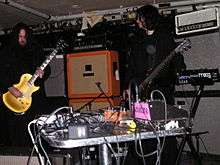Drone metal
Drone metal or drone doom[1] is a style of heavy metal that melds the slow tempos and heaviness of doom metal with the long-duration tones of drone music.[2][3] Drone metal is sometimes associated with post-metal[4] or experimental metal.[5]
| Drone metal | |
|---|---|
| Other names |
|
| Stylistic origins | |
| Cultural origins | Early 1990s, Seattle, Washington |
| Typical instruments | Electric guitar, bass guitar |
| Other topics | |
Characteristics
Typically, the electric guitar is performed with a large amount of reverb or audio feedback[2] while vocals, if present, are usually growled or screamed. Songs often lack beat or rhythm in the traditional sense and are typically very long. The experience of a drone metal performance has been compared by novelist John Wray in The New York Times to listening to an Indian raga in the middle of an earthquake.[2] Wray also states, "It's hard to imagine any music being heavier or, for that matter, very much slower."[2] A pioneer band of drone metal called Sunn O))) has indicated a kinship with sound sculpture.[2] Jan Tumlir indicates a "sustained infra-sound rumble of sub-bass—so-called brown noise".[3]
Connections with other art forms
Stephen O'Malley from Sunn O))) collaborated on an installation with artist Banks Violette, who has likened drone metal to the work of Donald Judd.[2] Tumlir locates a precedent in Robert Rauschenberg.[3] Violette points out, however, that drone metal is "as much a physiological phenomenon as an acoustic one",[2] with an attendant physicality. O'Malley has also mentioned an appreciation for Cormac McCarthy and Richard Serra.[1] Rhys Chatham's Essentialist included projections by Robert Longo.[5] Jim Jarmusch's 2009 film The Limits of Control features music by a number of drone metal groups.[6] Jarmusch said, "I love these kind of visual landscapes they make, and they really inspired things for me for my film ..., because when I write I'm listening to things that inspire me in the direction of whatever world I'm imagining. Boris and Sunn O))) and Earth were really instrumental in me just finding a place in my head."[7]
History
Precursors
Early guitar-produced drone effects go as far back as the krautrock (for example "Kluster 2" by Kluster, 1969) and early noise rock / industrial music era ("Metal Machine Music" by Lou Reed, 1975; "Stahlwerksynfonie" by Die Krupps, 1981).
1990s

Drone metal was first established by Earth,[8] a group from Olympia, Washington, formed in 1989, which has been described as "minimalist post-grunge".[2] Earth took inspiration from the sludge metal of Melvins and the minimalist music of La Monte Young, among other sources. Stephen O'Malley's group Burning Witch, formed five years later, also in Seattle, continued in this tradition, incorporating unusual vocals and bursts of audio feedback. The group initially recorded for the prominent powerviolence label Slap-a-Ham. O'Malley's subsequent group, Sunn O))),[2][3] initially formed as a tribute to Earth, is most responsible for the contemporary prominence of the drone metal style. Godflesh is also a stated influence on many groups. Boris,[2][9] from Tokyo, also developed a style of drone metal, parallel with the Seattle groups, as did Corrupted, from Osaka.
2000s
Nadja (Toronto), Locrian[10] (US), Jesu (UK), Black Boned Angel (Wellington, New Zealand), Khanate (New York City), Ocean (Portland, Maine), Growing[11] (New York City), KTL (Washington/London), Ascend[12] and Eagle Twin (USA),[13] Teeth of Lions Rule the Divine (Nottingham, England), Conan (Liverpool, England) and Moss (Southampton, England) are prominent drone metal groups that formed in the early 21st century. Noise musicians, such as Kevin Drumm and Oren Ambarchi, have also worked in the style.[14] Rhys Chatham's Essentialist project is a contribution to drone metal by an elder composer,[5] attempting to "arrive at an a priori essence of heavy metal, reducing it to a basic chord progression".[15]
See also
References
- Brandon Stosuy, "Heavy Metal: It's Alive and Flourishing", Slate, August 19, 2005. Access date: August 22, 2008.
- John Wray, "Heady Metal", New York Times, May 28, 2006. Access date: August 18, 2008.
- Jan Tumlir, "Primal dirge", Artforum, April 2006. Access date: August 22, 2008.
- Jon Caramanica, "The Alchemy of Art World Heavy Metal". International Herald Tribune, September 20, 2005. Access date: August 25, 2008.
- Steve Smith, "Where Classic Avant-Garde Gets a Hint of Heavy Metal", New York Times, September 13, 2006. Access date: August 28, 2008.
- Pitchfork news, March 11, 2009. Access date: March 21, 2009.
- Jim Jarmusch and Alan Licht, "Invisible Jukebox", The Wire 309, November 2009, p. 23.
- Jason Jackowiak, Splendid, September 14, 2005. "Archived copy". Archived from the original on 2008-09-27. Retrieved 2008-09-15.CS1 maint: archived copy as title (link) Access date: August 23, 2008.
- Spall, Oliver (2007-12-10). "Sunn O))) and Boris present Altar". Retrieved 2008-08-22.
- Stosuy, Brandon. "Locrian's Ode to Extinction". Pitchfork. Retrieved 8 March 2017.
- James Parker, The Boston Phoenix, June 15, 2006. "Archived copy". Archived from the original on 2008-12-08. Retrieved 2008-08-22.CS1 maint: archived copy as title (link) Access date: August 22, 2008
- Ample Fire Within review, "Soundcheck", The Wire, July 2008, p. 45.
- Kim Kelly, "Choice Cuts", Terrorizer #189, October 2009, p. 22.
- Joe Panzner, Sheer Hellish Miasma review, Stylus, September 1, 2003. "Archived copy". Archived from the original on 2008-08-28. Retrieved 2008-08-23.CS1 maint: archived copy as title (link) Access date: August 23, 2008.
- ,:.ELU OF THE NINE- Maurerische Trauermusik coming 2010.: